

![]()
![]()
|
James Duff Power Steering Conversion | |
|
Any one who has ever owned an Early Bronco with or
without power steering knows how difficult it is to steer when you
get in the rough stuff. Problems that I had with my 1973 Bronco
Sport's power steering included:
High RPM and the steering would be jittery or intermittent. I
would have to let the power steering sit for a while till I could
get full power back. When the power steering would get hot, it would shoot the dipstick out of the pump. I would go through power steering pumps once a year for leaks and noise problems. Once I put a locker in the front end, it was pure hell to get around in the rocks. I had often entertained getting a new system. As the money came, piece by piece I was going to replace stuff with bigger and badder components. The money just never seemed to be there. Always had to be used for other emergencies with the Bronco. Well, below is the story of my steering emergency!
| |
|
|
It was July 17th, 2000 and we were on a mission with a local club to clean a burnt out Jeep ZJ off one of our favorite trails here in Arizona called Lower Terminator. Once we moved the vehicle out of the ravine and positioned it for further action on another day, we proceeded to complete the trail. I came into this crevice in two wheel drive and it violently yanked the wheel out of my hand and jammed the wheel hard left. After yelling ouch, I backed up and put it in 4 wheel drive and proceeded to traverse the crevasse. I noticed soon after I passed this obstacle that my power steering was non-existent. |
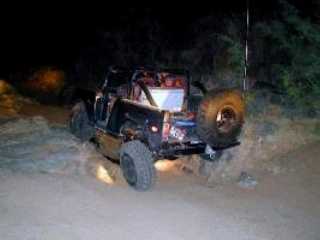 |
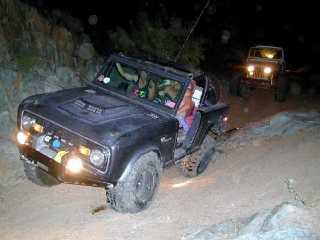 |
| I didn't realize until I saw these pictures that I had split my power steering box on that obstacle. On the road back to the parking lot where everyone was meeting, the steering was all over the place. When I got out to look at my suspension and steering components, I noticed a crack down the sector shaft. I was able to limp it home and park it till a replacement could be found. |
|
|
|
|
|
|
Little did I know when this happened, how rare the Ford Bronco Power Steering box really is. It was first offered as an option in 1973 until 1977. That means only 4 years of production and it did not come on all Broncos sold during those years. I called all over the country trying to find a used or new box. The big parts houses had the stock power steering boxes for $300-$500 dollars with a core ($99.99 - $300.00). I realized this was going to be a tough decision on what to do. After weighing all my options and remembering how horrible my stock box was with a locker in the rocks, I decided to go with something stronger. The major parts houses were selling kits to convert to F100 -150 power steering boxes. These have longer sector shafts and require modification to the frame. I wanted something practically bolt in. Enter the James Duff Power Steering Conversion Kit. |
|
This kit uses the
AGR SUPER BOX 2
Scout box, which is a
bolt in box using existing holes in the frame. Only one
additional hole had to be drilled. This kit also replaces the
stock pump with a
AGR SUPER P SERIES
PUMP which is
a Saginaw unit. I tried to piece together a system with all
the parts, brackets, belts and pulleys, but ended up being as
expensive as the kit and with a lot more labor on my part.
This kit comes with everything needed to bolt it right up to
your Bronco. I did order the truss that wraps the sector shaft
to help prevent and future problems with that
splitting.
|
|
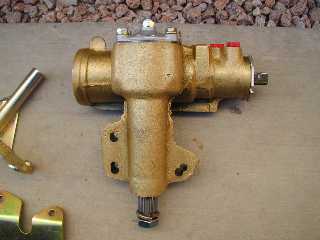 |
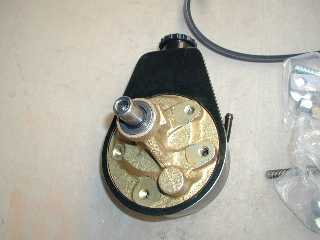 |
|
|
Once I pulled my old box off the frame, I cleaned up the area and painted it to prevent rust forming. I had to slightly grind the casting of the steering box to get it to clear the frame and wheel well. I had previously cut out my inner fender wells and it made this job extremely easy. My frame had been previously re-enforced with two plates of steel. On the inside of the frame I put a 1/2" plate and the outside got a 1/4" plate. This was welded to the frame to prevent bending, cracking or collapse. |
| This did create a couple of dilemmas for me. 1st, the bolts that James Duff had send were too short. I had to make a run to the hardware store to get Grade 8 bolts the right size. Also, due to the plate on the inner frame, the additional hole that I had to drill would place the nut against the radiator. So from the back side I drilled a hole and inset the nut and welded it in the frame flush. When the bolt was inserted it was cut flush so not to rub against the radiator |
|
|
|
This is a picture of the truss that I ordered from James Duff. This truss is used to strengthen the sector shaft area which is the weakest part of the power steering box. |
| This is what the installed box looks like with the truss installed. As you can see from the picture, the cut fender wells makes for easy access. Next is the install of the included Saginaw pump, brackets, pulleys and hoses. |
|
|
|
The next step in the installation was to assemble the bracketry for the Saginaw pump. The instructions were very straight forward and had all the correct hardware. |
|
Once the brackets were attached, the
provided pulley installation tool was used to press on the
provided pulley. Next the old power steering pump and hoses
were removed. The new saginaw pump was installed, belt
attached, and hoses routed. The stock power steering cooler
was bypassed because I kinked the tube trying to move it out
of the way to get the pump in.
|
|
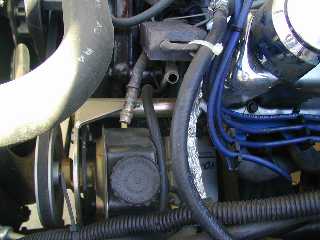 |
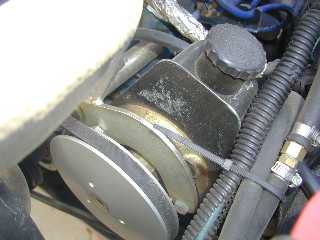 |
|
|
Once the lines were
attached, an in line cooler was put in front of the radiator,
and a dedicated fan was installed to push air through the
cooler at low speeds. James Duff recommends using synthetic
power steering fluid in their systems. I immediately went to
Pep Boys and bought Valvoline Synthentic Power Steering fluid.
|
| This is the factory power steering pump for the 1973 Ford Bronco |
|
|
|
This is the Saginaw replacement pump from James Duff. Better known as an AGR Super Pump |
| The nest step in the process is to fill the reservoir with fluid. Raise the front tires off the ground and hand turn the wheels back and forth a few times and refill the reservoir. Do it again then top off. Next start vehicle for a short time. Check the fluid again. Next start the engine and cycle the tires back and forth. Pull the cap off the reservoir and be sure you see fluid movement. If not shut the engine off and repeat the sequence. If you continue to run the engine with no flow, you will damage the pump. After all this, it's time for a road trip. Se sure to recheck all you bolts and use Locktight Red where applicable. |
|
|
|
This is a picture of the Bronco on Lower Terminator on the same obstacle that broke the steering box before. I let Bill Mish drive while I watch the components for play. Everything stayed tight. The box had to work some air pockets out of the system. After that, it was effortless steering. MISSION ACCOMPLISHED! One more note: This steering box is now a 3 1/2 turn box. This really took some time to get use to flying down dirt roads. The box is extremely responsive. Be careful until you are used to the new turning style! You do not want to oversteer on a wash board road! |
| For other steering related projects! | |
| Technical article and
photos are copyright © 1999-2004, Motoman's
Madness. Do not duplicate without express permission from
Greg Banfield aka Motoman!
|
Return to Motoman's Madness |